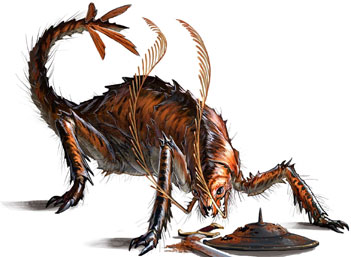By Alan McCoy from Dungeons & Dragons: Fundamentals
How to build challenging encounters against a Rust Monster
Note: This has been prepared utilizing only the 5E Core Rules. The Rust Monster can be found in the Monster Manual page 262.
Rust Monsters are unintelligent scavengers that roam subterranean passages searching for ferrous metals. While they prefer metals with a larger quantity of iron (Iron, Steel, Adamantine or Mithril) they can also consume many alloys of that contain lower quantities.
If you want to know more about rust monsters, read the rust monster entry which includes some tips about habitat, society and ecology of this awesome monster.
The short version: If it’s metal, it’s a Meal.
It is presumed that the Rust Monster is the result of magical experimentation, possibly by a Druid, a Wizard or some unknown being. The logical presumption is that they were designed to roam the approaches to the lair, aggressively pursuing those who carried the largest quantities of metal.
While this may have indeed been their origin, they have either escaped from captivity or have been captured and transferred from place to place. They are a very widespread defensive monster. It is known that these monsters can be trained but are usually illegal in urban environments due to their destructive capability and capacity. An Adult Rust Monster must consume roughly twenty pounds of iron each day to be considered well fed.
Rust Monsters are fast creatures with a very keen sense of smell when it comes to iron and iron alloys, they will pursue those that have large quantities of metal relentlessly and aggressively until their hunger is satisfied.
In the wild, Rust Monsters will attempt to lair near other subterranean monsters that find them unappetizing, they have been known to clean away the last remains of a battle.
Most often Rust Monsters are solitary, but they have been known to form small groups, usually a nest with newly hatched eggs.
Step 1) Let’s Review what we know about Rust Monsters
Rust Monsters are Medium Sized Monstrosities that have an insect like appearance, they are not insects however, possessing only four legs. Rust Monsters have two frond-like antennae that they use to corrode metals. While it is not efficient or useful in combat, they have similar frond like appendages on their tail (useful to prevent starvation).
Rust Monsters are extremely fast, capable of moving 40 feet per round.
Rust Monsters have above average Strength, Dexterity, Constitution and Wisdom, they have Poor Charisma and an Animal level intelligence.
Rust Monsters have Darkvision (60) and a Passive Perception of 11.
Rust Monsters can ‘Scent’ exactly, able to pinpoint the location of any iron with 30 feet.
Rust Monsters corrode any iron (or alloy) that hits or comes into contact with the Rust Monster. Essentially the weapon rapidly becomes useless and will fall apart in the wielders hand. Magical Weaponry is resistant but not immune to this effect.
Step 2) Determine the probable Strategy.
The animal level intelligence coupled to the above average wisdom indicates that the Rust Monster while not cunning, is somewhat wary. Unless starved, the creature will trail the group and might even eat any of their leavings rather than simply running in to attack them.
It is the rare adventuring party that doesn’t leave some metal scraps in the form of enemy armor, buckles, arrowheads and what not behind.
It is possible the that the Rust Monster will begin to consume and scavenge from the dead rather than approach the party directly.
Step 3) Determine Tactics
If forced into combat, the Rust monster begins by doing a run-through the party. Reaching out with its frond-like antennae it will touch all ferrous metal it can to begin the corrosion process. Additionally, any attempt to hit the monster with a metal weapon will probably begin to corrode it as well.
After the run through the Rust Monster will wait a few minutes, letting the weaponry and armor of the enemy corrode to uselessness, before returning to attack.
While it isn’t the Rust Monster’s doing, there are plenty of opportunistic attackers who realize the effect of a rust monster and will make their attack once the party has been weakened.
Step 4) DM Tips and Observations
Darkvision 60 feet is too short for a creature that has a movement of 40, increase to 80, probably 120.
Iron Scent: increase to 120 feet, to make it interesting.
How can an item attacked by a Rust Monster be made whole again? Is it possible? Better decide before they encounter one….
FYI: I allow a Mending Cantrip to restore a weapon to usefulness at the rate of +1 per spell. IF the weapon hasn’t been destroyed. Armor +1 per 10 minutes of mending.
An item DESTROYED may not be mended.
